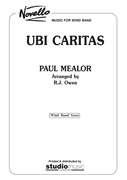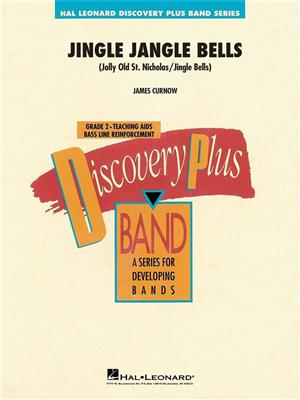Results
-
 £137.99
£137.99Three Onegin Dances Wind Band Set (Score & Parts)
Tchaikovsky is best known for his purely instrumental compositions. However, we must not underestimate him as a composer of operas. Many of his operas such as ?Pique Dame and Eugene Onegin are still performed regularly throughout the world. Eugene Onegin (also called Jevgeny Onegin), composed in 1877-1878, was not called an opera by Tchaikovsky himself, but "lyric scenes". The work is entirely dominated by lyricism. However, there are two moments that contrast sharply with this lyricism: two ball scenes, for which Tchaikovsky wrote a waltz and a polonaise.After opening with a less well-known allegro dansant, this arrangement features the aforementioned waltz, which can be considered a beautiful Russian equivalent of the Faust Waltz by Charles Gounod. In the opera, this waltz is actually played by a military band. The arrangement concludes with the pompous polonaise (also mentioned above) which opens the last act: the ideal music to characterize high aristocracy in the salon of a palace in St. Petersburg. 0:09:30
Estimated dispatch 7-14 working days
-
 £64.95
£64.95UBI CARITAS (Wind Band) - Mealor, Paul - Owen, R. J.
Composed for the marriage of His Royal Highness Prince William of Wales, K.G. to Miss Catherine Middleton. First performed by the Choirs of Westminster Abbey and Her Majesty's Chapel Royal, St James's Palace, conducted by James O'Donnell, at Westminster Abbey, Friday 29 April 2011. Duration: 4:00
Estimated dispatch 7-14 working days
-
 £89.99
£89.99Unity Fanfare (Concert Band - Score and Parts)
The Musikkapelle St. Johann in Tyrol commissioned Otto M Schwarz to compose an energetic and exciting fanfare for their band and that is exactly what they got. If you are looking for a work to open your concert with, this is it! Otto M. Schwarz' passion for lm scoring is evident as he e ectively mixes movie sounds into this fanfare. Festive chorales and heart warming melodies culminate in an exciting Finale Furioso! 03:47
Estimated dispatch 7-14 working days
-
 £50.50
£50.50The Last Gladiator - Timothy Loest
Experience the brutal energy of the Roman Colosseum in this larger-than-life work by Timothy Loest. Heart-pounding drums and sword-clashing sound effects tell the heroic story of St. Telemachus, a frail monk whose bravery brought the gladiatorial games to an end. Exhilarating and epic, The Last Gladiator will absolutely be a student and audience favorite!
Estimated dispatch 7-14 working days
-
 £53.50
£53.50Six Drummers Drumming
Using fragments from The Twelve Days of Christmas, Jolly Old St. Nicholas, and We Wish You a Merry Christmas, Johnnie has created a clever percussion feature sure to be a hit at your holiday concert and also fun for the entire band. The percussion parts can adjusted based on the number of players you have available, so just remember to change the title to fit your performance!
Estimated dispatch 7-14 working days
-
 £123.20
£123.203 Letzte Motetten - Anton Bruckner
Anton Bruckner (b. 4.9.1824, Ansfelden, d. 11.10.1896, Vienna) didn't have it easy. Throughout his life, the Austrian composer was plagued by self-doubt. Anton Bruckner came from a simple, rural background. After the death of his father, he was accepted as a choirboy at the monastery of Sankt Florian in 1837. After several years as a school assistant and his own organ and piano studies, he first worked as organist in St. Florian, then from 1855 as cathedral organist in Linz. Introduced to music theory and instrumentation by Simon Sechter and Otto Kitzler, he discovered Richard Wagner as an artistic role model, whom he admired throughout his life and also visited several times in Bayreuth.In 1868 Anton Bruckner became professor of basso continuo, counterpoint and organ at the Vienna Conservatory; ten years later court organist; and in 1891 finally honorary doctor of the University of Vienna. He was considered an important organ virtuoso of his era, but had to wait a long time for recognition as a composer. It was not until Symphony No.7 in E major, composed between 1881 and 1883, with the famous Adagio written under the effects of Wagner's death, that he achieved the recognition he had hoped for, even if he was reluctant to accept it given his inclination towards scepticism and self-criticism.Anton Bruckner was a loner who did not want to follow a particular school or doctrine. He composed numerous sacred vocal works, such as his three masses, the Missa Solemnis in B flat minor (1854), the Te Deum (1881-84) and numerous motets. As a symphonic composer, he wrote a total of nine symphonies and many symphonic studies from 1863 onwards, tending to revise completed versions several times over. Bruckner's orchestral works were long considered unplayable, but in fact were merely exceptionally bold for the tonal language of their time, uniting traditions from Beethoven through Wagner to folk music, on the threshold between late Romanticism and Modernism.Anton Bruckner composed about 40 motets during his lifetime, the earliest a setting of Pange lingua around 1835, and the last, Vexilla regis, in 1892.Thomas Doss has compiled some of these motets in this volume for symphonic wind orchestra.These motets show many characteristics of personal expression, especially Bruckner's colourful harmony in the earlier works, which is in places aligned with Franz Schubert (changes between major and minor; and movements in thirds). Later works are characterised by many components which, in addition to the expanded stature of the movements, include above all a sense of the instrumentation as an outward phenomenon and the harmony as a compositional feature that works more internally. Some aspects of Bruckner's work are the result of his long period of study, which familiarised him not only with the tradition of his craft, but also gave him insights into the "modernity" of his time in such composers as Wagner, Liszt and Berlioz.From this developed his personal standpoint, which always pursues the connection between the old and the new.
Estimated dispatch 7-14 working days
-
 £256.00
£256.0014 Motetten - Anton Bruckner
Anton Bruckner (b. 4.9.1824, Ansfelden, d. 11.10.1896, Vienna) didn't have it easy. Throughout his life, the Austrian composer was plagued by self-doubt. Anton Bruckner came from a simple, rural background. After the death of his father, he was accepted as a choirboy at the monastery of Sankt Florian in 1837. After several years as a school assistant and his own organ and piano studies, he first worked as organist in St. Florian, then from 1855 as cathedral organist in Linz. Introduced to music theory and instrumentation by Simon Sechter and Otto Kitzler, he discovered Richard Wagner as an artistic role model, whom he admired throughout his life and also visited several times in Bayreuth.In 1868 Anton Bruckner became professor of basso continuo, counterpoint and organ at the Vienna Conservatory; ten years later court organist; and in 1891 finally honorary doctor of the University of Vienna. He was considered an important organ virtuoso of his era, but had to wait a long time for recognition as a composer. It was not until Symphony No.7 in E major, composed between 1881 and 1883, with the famous Adagio written under the effects of Wagner's death, that he achieved the recognition he had hoped for, even if he was reluctant to accept it given his inclination towards scepticism and self-criticism.Anton Bruckner was a loner who did not want to follow a particular school or doctrine. He composed numerous sacred vocal works, such as his three masses, the Missa Solemnis in B flat minor (1854), the Te Deum (1881-84) and numerous motets. As a symphonic composer, he wrote a total of nine symphonies and many symphonic studies from 1863 onwards, tending to revise completed versions several times over. Bruckner's orchestral works were long considered unplayable, but in fact were merely exceptionally bold for the tonal language of their time, uniting traditions from Beethoven through Wagner to folk music, on the threshold between late Romanticism and Modernism.Anton Bruckner composed about 40 motets during his lifetime, the earliest a setting of Pange lingua around 1835, and the last, Vexilla regis, in 1892.Thomas Doss has compiled some of these motets in this volume for symphonic wind orchestra.These motets show many characteristics of personal expression, especially Bruckner's colourful harmony in the earlier works, which is in places aligned with Franz Schubert (changes between major and minor; and movements in thirds). Later works are characterised by many components which, in addition to the expanded stature of the movements, include above all a sense of the instrumentation as an outward phenomenon and the harmony as a compositional feature that works more internally. Some aspects of Bruckner's work are the result of his long period of study, which familiarised him not only with the tradition of his craft, but also gave him insights into the "modernity" of his time in such composers as Wagner, Liszt and Berlioz.From this developed his personal standpoint, which always pursues the connection between the old and the new.
Estimated dispatch 7-14 working days
-
 £285.00
£285.00Mosaici Bizantini - Franco Cesarini
To mark the 30th anniversary of Mosaici Bizantini Franco Cesarini decided to publish this revised version. He added a few instruments to the instrumentation and completely revised the notation. The work is now available in large-sized full score and exclusively from the composer's publishing house.For this grand work, Franco Cesarini was inspired by three byzantine mosaics, which can be seen in churches in Venice and Palermo. He took the musical motives from Gregorian chants.The mosaics concerned depict the following extracts from "The Gospel according to St. Matthew":1. The Nativity2. The Temple of Jerusalem3. Angel of the ResurrectionThis new, revised version of this masterpiece will delight both the orchestra and the audience!
Estimated dispatch 7-14 working days
-
 £53.50
£53.50Jingle Jangle Bells - James Curnow
Featuring the familiar carols ft.Jolly Old St. Nicholas ft. and ft.Jingle Bells ft., here is a creative and concise overture that interweaves melodies from both tunes. Using a single tempo throughout and a bright festive mood,this is perfect as a holiday opener or closer!
Estimated dispatch 7-14 working days
-
 £152.99
£152.99The Legend Of Spirit Island - Philip Sparke
The Legend of Spirit Island was commissioned by the Twin Ports Wind Orchestra, Duluth, Minnesota (Mark Whitlock, conductor), to honour the euphonium player, Dick Carlson. The piece takes its title from a local legend about Spirit Island, which lies in a gap of the St. Louis River called Spirit Lake. The legend tells the story of Chaska, the son of a Dakota Chief, and Wetona, the daughter of Ojibwe Chief Buckado. He was handsome and she was beautiful; it wasn't long before they fell in love. This is a challenging euphonium solo in which the versatile soloist can explore very expressive melodic sequences, as well as energetic, technical sections.
Estimated dispatch 7-14 working days
